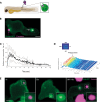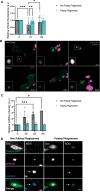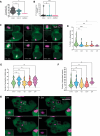A subset of neutrophil phagosomes is characterised by pulses of Class I PI3K activity
- PMID: 40692416
- PMCID: PMC12444860
- DOI: 10.1242/dmm.052042
A subset of neutrophil phagosomes is characterised by pulses of Class I PI3K activity
Abstract
Class I PI3 kinases (PI3Ks) coordinate the delivery of microbicidal effectors to the phagosome by forming phosphatidylinositol (3,4,5)-trisphosphate (PIP3). However, the dynamics of PIP3 in neutrophils during a live bacterial tissue infection are unknown. We therefore developed an in vivo, live zebrafish infection model that enables visualisation of dynamic changes in Class 1 PI3K signalling in neutrophil phagosomes in real time. We identified that, on ∼12% of neutrophil phagosomes, PHAkt-eGFP, a reporter for Class 1 PI3K signalling, repeatedly fades and re-recruits in pulsatile bursts. This phenomenon occurred on phagosomes containing live and dead bacteria as well as beads, and was dependent on the activity of the Class 1 PI3K isoform PI3Kγ. Detailed imaging suggested that pulsing phagosomes represent neutrophils transiently re-opening and re-closing phagosomes, a conclusion supported by observations that a subset of phagosomes in human neutrophils rapidly accumulate dye from the extracellular space. Therefore, we propose that some neutrophil phagosomes remain unsealed and are consequently able to exchange contents with the extracellular environment, with implications for phagosome fate and communication with surrounding cells.
Keywords: Neutrophils; Phagocytosis; Phagosome maturation; Phosphatidylinositol (3,4,5)-trisphosphate; Zebrafish.
© 2025. Published by The Company of Biologists.
Conflict of interest statement
Competing interests The authors declare no competing or financial interests.
Figures






References
MeSH terms
Substances
Grants and funding
LinkOut - more resources
Full Text Sources

